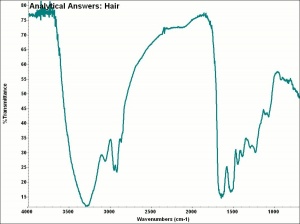Difference between revisions of "Hair"
(username removed) |
|||
| (5 intermediate revisions by 3 users not shown) | |||
| Line 1: | Line 1: | ||
| − | [[File:17.2251-SC71549.jpg|thumb|]] | + | [[File:17.2251-SC71549.jpg|thumb|Mallet for drum<br>MFA# 17.2251]] |
== Description == | == Description == | ||
| + | [[File:43.1769-161-10.jpg|thumb|English Doll<br>MFA# 43.1769]] | ||
| + | Cylindrical filaments that grow from the skin of mammals. Hair is a column of overlapping, fused cells that are composed of the protein [[keratin]]. Hair is composed of three parts: the innermost column is the medula, the surrounding live cells (the cortex) contain pigment, and the outermost dead transparent cells are the cuticular scales. Hair grows from follicles embedded in the skin. The portion of the hair outside of the skin is called the shaft. Fine, closely spaced hair that covers most of an animal's body is called [[fur]]. Dense, soft, curled hair is called [[wool]]. Coarse, stiff hairs are called [[bristle|bristles]], spines, or [[quill|quills]]. [[Horsehair]] and cattle hair have been used for brushes, plaster binders, [[haircloth]], and upholstery stuffing. Rabbit hair, often called rabbit fur, has been used to make felt hats. | ||
| − | |||
| − | |||
| − | |||
== Synonyms and Related Terms == | == Synonyms and Related Terms == | ||
| Line 11: | Line 10: | ||
[[[SliderGallery rightalign|aaiHAIR.jpg~FTIR]]] | [[[SliderGallery rightalign|aaiHAIR.jpg~FTIR]]] | ||
| − | == | + | == Physical and Chemical Properties == |
Human hair is strong (one strand can hold 100g) | Human hair is strong (one strand can hold 100g) | ||
== Additional Images == | == Additional Images == | ||
| − | |||
<gallery> | <gallery> | ||
File:00000096.jpg|Drawing of various hair types | File:00000096.jpg|Drawing of various hair types | ||
| Line 24: | Line 22: | ||
</gallery> | </gallery> | ||
| − | + | == Resources and Citations == | |
| − | == | ||
* Walter C. McCrone, John Gustave Delly, ''The Particle Atlas'', W. McCrone Associates, Chicago, IV, 1972 | * Walter C. McCrone, John Gustave Delly, ''The Particle Atlas'', W. McCrone Associates, Chicago, IV, 1972 | ||
| Line 31: | Line 28: | ||
* Matt Roberts, Don Etherington, ''Bookbinding and the Conservation of Books: a Dictionary of Descriptive Terminology'', U.S. Government Printing Office, Washington DC, 1982 | * Matt Roberts, Don Etherington, ''Bookbinding and the Conservation of Books: a Dictionary of Descriptive Terminology'', U.S. Government Printing Office, Washington DC, 1982 | ||
| − | * ''Encyclopedia Britannica'', http://www.britannica.com Comment: "hair." | + | * ''Encyclopedia Britannica'', http://www.britannica.com Comment: "hair." (Accessed 17 Nov. 2004). |
| − | * | + | * Olympus Microscopy Resource Center at http://www.olympusmicro.com/galleries/abramowitz/pages/hairshaft1large.html |
| − | * Wikipedia | + | * Wikipedia: http://en.wikipedia.org/wiki/Hair (Accessed Nov. 2, 2005) |
* G.S.Brady, ''Materials Handbook'', McGraw-Hill Book Co., New York, 1971 | * G.S.Brady, ''Materials Handbook'', McGraw-Hill Book Co., New York, 1971 | ||
Latest revision as of 14:44, 3 September 2020
Description
Cylindrical filaments that grow from the skin of mammals. Hair is a column of overlapping, fused cells that are composed of the protein Keratin. Hair is composed of three parts: the innermost column is the medula, the surrounding live cells (the cortex) contain pigment, and the outermost dead transparent cells are the cuticular scales. Hair grows from follicles embedded in the skin. The portion of the hair outside of the skin is called the shaft. Fine, closely spaced hair that covers most of an animal's body is called Fur. Dense, soft, curled hair is called Wool. Coarse, stiff hairs are called bristles, spines, or quills. Horsehair and cattle hair have been used for brushes, plaster binders, Haircloth, and upholstery stuffing. Rabbit hair, often called rabbit fur, has been used to make felt hats.
Synonyms and Related Terms
pelage; medula; cortex; cuticular scales; hår (Dan., Nor., Sven.); Haar (Deut., Ned.); pelo (Esp.); pilosité humaine (Fr.); cabelo (Port.);
Physical and Chemical Properties
Human hair is strong (one strand can hold 100g)
Additional Images
Resources and Citations
- Walter C. McCrone, John Gustave Delly, The Particle Atlas, W. McCrone Associates, Chicago, IV, 1972
- Matt Roberts, Don Etherington, Bookbinding and the Conservation of Books: a Dictionary of Descriptive Terminology, U.S. Government Printing Office, Washington DC, 1982
- Encyclopedia Britannica, http://www.britannica.com Comment: "hair." (Accessed 17 Nov. 2004).
- Olympus Microscopy Resource Center at http://www.olympusmicro.com/galleries/abramowitz/pages/hairshaft1large.html
- Wikipedia: http://en.wikipedia.org/wiki/Hair (Accessed Nov. 2, 2005)
- G.S.Brady, Materials Handbook, McGraw-Hill Book Co., New York, 1971
- Van Nostrand's Scientific Encyclopedia, Douglas M. Considine (ed.), Van Nostrand Reinhold, New York, 1976
- Random House, Webster's Encyclopedic Unabridged Dictionary of the English Language, Grammercy Book, New York, 1997
- The American Heritage Dictionary or Encarta, via Microsoft Bookshelf 98, Microsoft Corp., 1998






